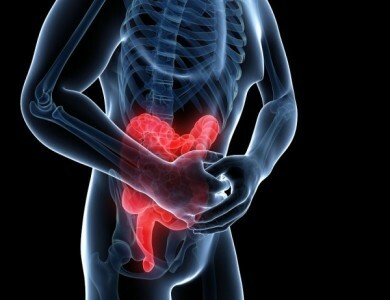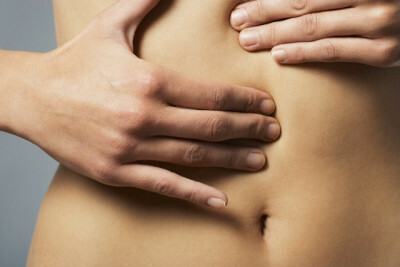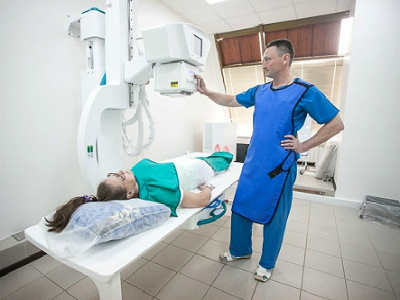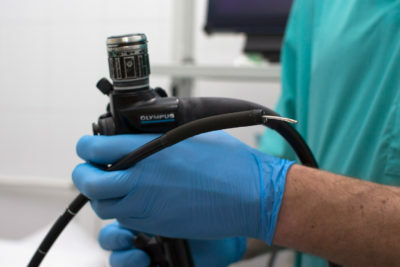1 Symptom
A nonspecific inflammatory disease that occurs in a chronic form that can affect the entire gastrointestinal tract is called Crohn's disease. Crohn's disease is rare. If the disease began its "path" from the small intestine, which happens in most cases of its course, then, after hitting the entire ileum region, it passes into the cecum, causing a number of severe complications in neighboring organs of the abdominal cavity. The process is irreversible, proceeds with variable remissions, but the affected intestinal mucosa is no longer able to recover. Destruction of all layers of the intestinal wall leads to organic lesions of the intestinal tract, creating simply a fertile environment for the reproduction of bacterial infections. The tissues of the mucosa and intestinal walls turn into a loose substrate, on which pathogenic microorganisms begin to parasitize, "paving" their way to the neighboring organs and abdominal cavity.

Recommended to read
- Duodenal reflux
- How colonoscopy of the intestine is made
- Symptoms of intestinal disease
- Effective agent for gastritis and stomach ulcer
The male is most likely to have Crohn's disease from 20 to 40 years of age. Usually, the disease can manifest itself in this age range. Occasionally, Crohn's disease occurs in children 10 years of age.
2 Characteristic manifestations of
The disease is so nonspecific that the symptoms of Crohn's disease are very limited and do not give a complete picture for the final diagnosis. Sometimes a person suffers from severe cramping pain in the ileum, where the first parts of the intestine are affected at the initial stage of the disease. Such pain symptoms of Crohn's disease can be mistaken for the symptoms of an inflamed appendix. The doctor after palpation diagnosis sends the patient to an operation to remove the intestinal tonsil. And after the surgical intervention, the areas of the intestinal tract affected by Crohn's disease are definitely visible. And often in such cases, the diagnosis of the disease occurs definitively.
And yet the symptoms characteristic of Crohn's disease are, and you can track them. The body signals about help, and they can not be ignored:
-
 IMPORTANT TO KNOW! Gastritis? Ulcer? To have a stomach ulcer not turned into cancer, drink a glass. ..Read the article & gt; & gt;
IMPORTANT TO KNOW! Gastritis? Ulcer? To have a stomach ulcer not turned into cancer, drink a glass. ..Read the article & gt; & gt;
- cramping pain in the groin on the right;
- frequent diarrhea with bloody fragments;
- nausea;
- vomiting;
- bloating of abdominal cavity;
- enhanced gassing;
- elevated temperature;
- febrile phenomena;
- osteoporosis;
- increased weakness;
- fatigue;
- hemorrhoids;
- decreased hemoglobin;
- lack of appetite;
- weight loss;
- cholesterol stone formation in the gallbladder;
- skin rashes;
- rheumatoid pain;
- stomatitis;
- decreased vision.

3 Etiology of the onset of
Medicine identifies the following causes of Crohn's disease.
Infectious agents. The specific causative agent of this disease has not yet been identified. However, it is commonly believed that a complete picture of the disease is determined by certain infections that contribute to the "birth" of the disease. For example, intestinal sticks, cholera vibrio, salmonella, intestinal flu bacteria, pseudotuberculosis, korepodobnye viruses, helminths.
Genetic heredity. Crohn's disease is usually detected in blood relatives. There are suggestions that there is a mutation of one of the genes that has a repeat of some amino acids.

Weakened immunity. The weakness of the immune system in any case qualitatively affects all kinds of susceptibility to various nonspecific infections.
-
 Gastroenterologist. IMPORTANT: "I beg you, if you started to worry about abdominal pain, heartburn, nausea, do not do gas. .."Read more & gt; & gt;
Gastroenterologist. IMPORTANT: "I beg you, if you started to worry about abdominal pain, heartburn, nausea, do not do gas. .."Read more & gt; & gt;
Autoimmune diseases. The development of antibodies against the cells of certain internal organs leads not only to tumor processes, but also to the destruction of cell membranes of connective tissues. For example, with systemic lupus erythematosus, similar changes in the connective tissue of internal organs can occur. Some scientists attribute Crohn's disease to similar autoimmune diseases.
Adverse environmental factors. To speak about the catastrophic ecological state of the environment for today can be very long. The quality of drinking water, air and precipitation deteriorates every year. A person living in a metropolis is constantly experiencing the influence of pathogenic microorganisms. For example, spores of mold fungi are constantly present in the air we breathe.
4 Clinical picture of
Since the diagnosis of Crohn's disease is complicated on the basis of multipolar symptoms, and only inflammatory processes can be detected in the laboratory, in the gastroenterology for a more subtle diagnosis a number of instrumental methods of investigation are used:
- Colonoscopic method. The intestine is inserted probing element, examining the surface of the mucosa, transmitting the video signal to the monitor.
- Endocapsular colonoscopy method. Through the mouth, if swallowed, a capsule with a micro-video camera is inserted, which, moving along the intestine, outputs the video signal to the monitor.
- The gastroduodenoscopy method. Diagnosis of Crohn's disease using this method is carried out as follows: a probing element is inserted into the intestine, reaching the cavity of the duodenum and even the gastric sphincter. Using a micro-video camera, the monitor receives an image of the condition of the mucous surface and the walls of the organs.
- Ultrasonic method. With the help of ultrasound, the presence and volume of free fluid in the abdominal cavity is revealed, which is a symptom of Crohn's disease.
- Radiographic contrast method. The determination of the state of the intestine occurs with the aid of barium reception and X-ray radiography of the abdominal cavity. Usually, with such studies, cracks in the intestinal walls and adhesions are clearly visible.
- Computed tomography. A procedure that allows you to identify complications and abscesses.
- MRI of the intestine. An aqueous solution is introduced into the intestine, which allows to assess the state of the intestinal walls, revealing the presence of fistulas, ulcers and hyperemia.
- Electrogastroenterography. A method that allows to investigate the motor function of the intestine.
ADVICE FROM THE MAIN GASTROENTEROLOGIST
Korotov SV: "I can recommend only one remedy for the rapid treatment of Ulcer and Gastritis, which is now recommended by the Ministry of Health. .." Read the reviews & gt; & gt;

5 Diseases of the disease
The disease is classified by the localization of the inflammatory process. The most typical pathologies are listed below:
- ileitis is an inflammatory process affecting only the ileum;is observed in 35% of cases;
- ileocolita - damage to the ileum and large intestine;occurs in 45% of cases;
- is an itoinyleitis-a lesion of the entire small intestine;
- granulomatous colitis is a lesion of the large intestine;
- gastro-duodenal form of Crohn's disease;
- anal form - organic lesions of the anus.

Depending on the duration of the disease, the scale of its location, the presence of complications, the general clinical picture, you can define several more typical classifications.
6 Diet
In order to alleviate the condition of the patient, you must daily adhere to the strictest diet. Diet is one of the important factors that prolong the life of a patient.
As the process of absorption of nutrients, trace elements, vitamins entering the digestive tract with food in the acute stage of the disease is almost completely difficult due to mucosal lesions, it is necessary to use other ways of supplying the body with missing elements.

Usually, nutrient droppers, subcutaneous injections are prescribed.
In cases where Crohn's disease of the colon is progressing, granulomatous colitis, some nutrients are still absorbed in the walls of the duodenum and small intestine.
This patient can be recommended the following diet:
- vegetable soups;
- compotes of dried fruits;
- enveloping cereals;
- were jammed;
- boiled fish;
- low-fat steamed meat;
- steam omelettes.
In general, with such diseases it is easier to determine what can not be eaten. Categorically contraindicated products that cause excessive gas formation, salty, fried, smoked, sour-milk products, raw fruits, raw vegetables, but the greatest harm can cause sweet desserts.
Food should be divided, eliminating overeating, excessive fluid, tonic drinks, alcohol.
7 Drug therapy
Treatment of Crohn's disease by modern methods in adults is determined by gastroenterologists exclusively for each patient.
In addition to taking medications that support the intestinal microflora, it is necessary to be concerned about neighboring organs that can undergo organic pathological changes, and also try to saturate the body with the necessary set of trace elements and nutrients.

Phytotherapy with pathological disorders of the gastrointestinal tract is well established. Useful broths of herbs, reducing thirst, giving antiseptic effect, wound healing. In any case, you can take almost every day decoctions of chamomile pharmacy, blueberries, sage, St. John's wort, peristalsis, plantain, mint, lemon balm.
Of pharmacy drugs are prescribed Mesalazine, which provides anti-recurrence effect.
Of course, you can not do without antibiotics in cases where the processes of putrefactive decomposition of the intestinal wall.
Fluoroquinolone antibiotics are available and effective, such as Ciprofloxacin, Lomefloxacin, Norfloxacin, Ofloxacin, Pefloxacin.
In the treatment of deep pathologies, when the disease is diagnosed in later stages, accompanied by severe abdominal pain, persistent nausea, frequent bloody diarrhea, intestinal obstruction, intestinal wall perforations, surgical intervention is shown that gives the patient relief after a relatively long period.
8 Useful advice
Treatment of Crohn's disease will give a long-awaited effect and a long-term remission in those cases when the patient will be provided with the most comfortable conditions that presuppose rest, completely eliminating stressful situations, physical activity, weight lifting, atmospheric pressure drops, lack of sleep, overeating, unsanitary conditions.
Smoking causes great harm to the patient's body. Smoking is considered one of the risk factors for developing Crohn's disease in adults.
Drug therapy is aimed at prompt relief of the patient's condition, primarily, it is designed to stop the process of destruction of the intestinal tissues, to maintain the absence of relapses as long as possible, restraining the inflammatory processes and preventing complications. This is especially important in the treatment of children. In childhood, all body systems need full nutrition, increased immunity, adaptive programs that give a mortgage to the young body for the rest of their lives.
- 1 Symptom
- 2 Characteristic manifestations
- 3 Etiology of occurrence
- 4 Clinical picture
- 5 Diseases
- 6 Diet
- 7 Medication therapy
- 8 Useful advices
Crohn's disease has a nonspecific development and current, little studied, can affect any organ of the digestive system is so critical that even a lethal outcome is possible. There is a lot of inexplicable and unexplained inflammatory processes in the human body due to poor symptoms and unpredictability of genetic inheritance. First of all, such ailments include autoimmune diseases, in which the human body starts producing antibodies against its own cells.
Do you have gastritis?
GALINA SAVINA: "How easy is it to cure gastritis at home for 1 month. A proven method - write down a recipe. ..!"Read more & gt; & gt;



